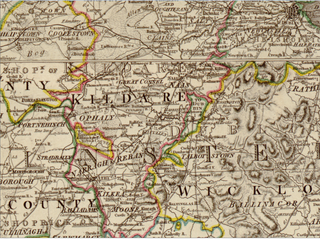
Duke of Leinster is a title in the Peerage of Ireland and the premier dukedom in that peerage. The subsidiary titles of the Duke of Leinster are: Marquess of Kildare (1761), Earl of Kildare (1316), Earl of Offaly (1761), Viscount Leinster, of Taplow in the County of Buckingham (1747), Baron Offaly (1620) and Baron Kildare, of Kildare in the County of Kildare (1870). The viscounty of Leinster is in the Peerage of Great Britain, the barony of Kildare in the Peerage of the United Kingdom, and all other titles in the Peerage of Ireland. The courtesy title of the eldest son and heir of the Duke of Leinster is Marquess of Kildare. The Duke of Leinster is the head of the House of Kildare.

Earl of Drogheda is a title in the Peerage of Ireland. It was created in 1661 for The 3rd Viscount Moore.

Lieutenant-General James FitzGerald, 1st Duke of Leinster, PC (Ire), styled Lord Offaly until 1744 and known as The Earl of Kildare between 1744 and 1761 and as The Marquess of Kildare between 1761 and 1766, was an Irish nobleman, soldier and politician.

The FitzGerald/FitzMaurice Dynasty is a Cambro-Norman, Anglo-Norman and later Hiberno-Norman aristocratic dynasty.. They have been peers of Ireland since at least the 13th century, and are described in the Annals of the Four Masters as having become "more Irish than the Irish themselves" or Gaels, due to assimilation with the native Gaelic aristocratic and popular culture. The dynasty has also been referred to as the Geraldines. They achieved power through the conquest of large swathes of Irish territory by the sons and grandsons of Gerald of Windsor. Gerald of Windsor was a Norman castellan in Wales, and he is the male progenitor of the FitzMaurice and FitzGerald Dynasty.
This is a list of people who have served as Lord Lieutenant of County Tipperary between 1831 and 1922.
This is a list of people who served as Lord Lieutenant of County Waterford.
This is a list of people who have served as Lord Lieutenant of Queen's County.
This is a list of people who served as Lord Lieutenant of County Meath, Ireland.
This is a list of people who served as Lord Lieutenant of County Clare.
This is a list of people who have served as Lord-Lieutenant of Wexford.
This is a list of people who have served as Lord-Lieutenant of Longford.
This is a list of people who have served as Lord-Lieutenant of Mayo.
This is a list of people who have served as Lord-Lieutenant of County Cork.
This is a list of those who have served as Lord Lieutenant of King's County.
This is a list of people who have held the post of Lord Lieutenant of County Galway.

William Robert FitzGerald, 2nd Duke of Leinster, KP, PC (Ire) was an Irish liberal politician and landowner. He was born in London.

Augustus Frederick FitzGerald, 3rd Duke of Leinster, etc. was an Anglo-Irish peer and freemason, styled Marquess of Kildare from birth until 1804. He was born and died in Carton House. FitzGerald was Grand Master of the Grand Lodge of Ireland for most of the 19th century, holding the post for 61 years from 1813 until 1874.

Charles William FitzGerald, 4th Duke of Leinster,, styled Marquess of Kildare until 1874, was an Irish peer and politician.

The High Sheriff of Kildare was the British Crown's judicial representative in County Kildare, Ireland from the 16th century until 1922, when the office was abolished in the new Free State and replaced by the office of Kildare County Sheriff. The High Sheriff had judicial, electoral, ceremonial and administrative functions and executed High Court Writs. In 1908, an Order in Council made the Lord Lieutenant the Sovereign's prime representative in a county and reduced the High Sheriff's precedence. However the sheriff retained his responsibilities for the preservation of law and order in the county. The usual procedure for appointing the sheriff from 1660 onwards was that three persons were nominated at the beginning of each year from the county and the Lord Lieutenant then appointed his choice as High Sheriff for the remainder of the year. Often the other nominees were appointed as under-sheriffs. Sometimes a sheriff did not serve his full term due to death or another event, and another sheriff was then appointed for the remainder of the year. The dates given in this article are the dates of appointment.








